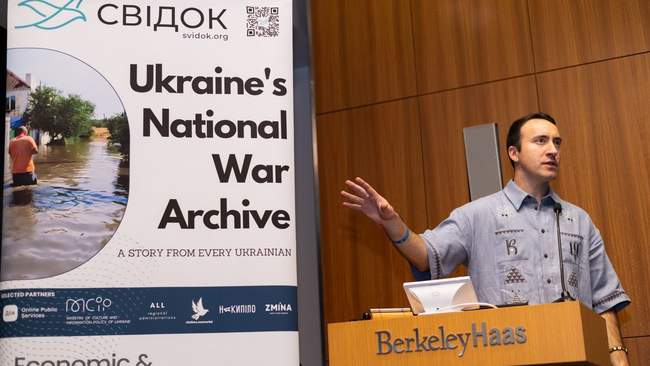Меню
Social networks
Sections
Feb. 10, 2025, 7:57 p.m.
Berkeley Exhibition Highlights Russia's Environmental Crimes in Ukraine
Цей матеріал також доступний українською163

PHOTO: Channel 24/Tetyana Redko
In the United States, the University of Berkeley hosted a unique exhibition dedicated to Russia's environmental crimes in Ukraine. The organizers presented evidence of ecocide: photo and video materials collected on the Svidok.org platform, where Ukrainians can document the environmental consequences of the war.
According to Channel 24, leading experts in ecology and environmental protection spoke at the event, explaining the catastrophic consequences of the war.
According to Anastasia Fedyk, Berkeley professor and chief economist at AI for Good Foundation, the initiative's participants not only collect evidence for litigation but also develop plans to restore Ukraine's destroyed ecosystems.
We urge Ukrainians to provide evidence of ecocide, because the scale of the environmental catastrophe goes far beyond the front line. This is a tragedy that will affect future generations," the professor emphasized.
Visitors could see footage of flooded towns after the Kakhovka hydroelectric power plant explosion, destroyed forests, ruined nature reserves, and mined fields. The exhibition was attended by scientists, students and public figures. They admitted that what they saw was shocking.
Currently, 20% of Ukraine's protected areas have been damaged. Of these, 13 national parks and 8 nature reserves are occupied. More than 24 thousand hectares of forest have been destroyed. CO₂ emissions due to the war have exceeded 180 million tons - more than in 175 countries.
 PHOTO: Channel 24/Tetyana Redko
PHOTO: Channel 24/Tetyana Redko
139 thousand km² of Ukrainian land remain mined. This causes $11.2 billion in damage annually. Complete demining could cost more than $37 billion.
There are 13 national parks, 8 nature reserves and 2 biosphere reserves under occupation. In total, 20% of the country's protected areas have been affected. Shelling and fires have destroyed more than 24,000 hectares of forest, and a third of Ukraine's forests have been severely damaged.
The explosion of the Kakhovka hydroelectric power plant on June 6, 2023, was a separate blow to the environment. The result was a large-scale disaster: flooding of 80 towns and villages, destruction of a large part of the Kherson region, and environmental damage of more than $14 billion.
 PHOTO: Channel 24/Tetyana Redko
PHOTO: Channel 24/Tetyana Redko
According to the Ministry of Environment, more than 7,000 crimes against the environment have been officially recorded, and the total environmental damage from Russian aggression exceeds UAH 3.5 trillion, and this figure is not final.
The organizers emphasize that this evidence is needed not only to draw the world's attention but also to bring the perpetrators to justice. The event also included an auction that raised $12,000 to support the Ukrainian military, including the purchase of tactical medicine for the Kraken special forces.
The war unleashed by Russia against Ukraine has caused significant environmental damage that will take decades to recover. The steppe ecosystems in the south and east of the country have suffered the most. Environmental losses exceed the damage from destroyed infrastructure, as they include land contamination, soil, water, and air pollution, as well as large-scale forest fires.
 PHOTO: Channel 24/Tetyana Redko
PHOTO: Channel 24/Tetyana Redko
Recently, in Mykolaiv region, the environmental damage caused to protected areas as a result of the full-scale war was estimated at 300 billion hryvnias. As a result of the fighting, 96% of the land area of the Kinburn Peninsula was burned in flames, causing a large-scale environmental disaster. More than 121 hectares of the Black Sea Biosphere Reserve also sustained significant damage.
Meanwhile, in the Odesa region, utilities have begun cleaning the coast from oil pollution. Experts emphasize the importance of a quick response to prevent further spread of pollution and minimize the environmental impact on the region.











